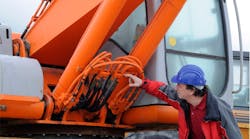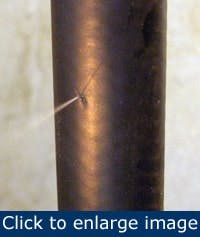“All hoses will eventually fail, it’s just a matter of when” is an often ignored, but essential fact to remember when working with hydraulic hoses. Moreover, if a hose suddenly fails, it can have dire consequences, including increased labor and material cost, unscheduled downtime, and, most importantly, injury of those working on or near the hose. Avoiding failure should be a prime directive for any process or application that uses hydraulic hoses but, unfortunately, that’s not always the case.
Although proactive hose assembly replacement is the most cost-effective method for dealing with potential hose failure, many users mistakenly believe that being reactive is a better option. Typical comments from reactive advocates are:
- “I can’t afford to shut down my process to replace a hose assembly.”
- “I’ll wait until it fails.”
- “I don’t have the time or the personnel available to fix the hose assembly right now.”
And there is the financial aspect typified by, “Why spend money to fix something before it’s broken?” Any of these attitudes can quickly fulfill the prophecy of a disaster waiting to happen.
Why spend the time and money to replace a hose assembly that has not failed? Here’s the answer: you run the risk of having the hose assembly fail at an inopportune time. Is there ever an opportune time for a hose failure? Any hose failure, at any time, results in unscheduled downtime and extra costs.
Be proactive, not reactive
A proactive hose maintenance program is more cost effective and ultimately provides a number of other advantages. It’s essential for hydraulic hose users to look beyond the initial costs of hose assembly replacement to its total cost, which includes the cost of the assembly plus labor, lost fluid,downtime, along with safety considerations. A scheduled replacement is far more cost-effective than reacting to a hose assembly failure, when material and labor costs will be higher and the potential for personnel injury can be serious.
Hydraulic hose can and will age whether it’s in normal service conditions or unused in storage. Hose failure isn’t an indication of poor product performance, but rather natural degradation.
[pullquote]A good analogy is automobile tires. Similar to some hydraulic hose, they’re made of rubber, an organic compound that ages naturally. The heat and friction a tire encounters during its working life also ages rubber. Tires experience a lot of abuse from road surfaces, highway driving, weather conditions and routine use.
Most drivers are vigilant about replacing tires as soon as they show signs of wear, cracking, blisters, bubbles, low or smooth treads, or bulges. Not replacing a worn tire can cause an accident or breakdown. It’ll be far more expensive and dangerous to replace blown-out tire in a roadside emergency as opposed to proactive replacement it at a more convenient time.
Similar to car tires, hydraulic hose will show signs of wear that include cracking, blisters and bubbles. Nevertheless, many users think nothing of running hydraulic hoses that show evidence of wear for days, weeks or even longer. Yet, they’d never drive a car that had a worn tire, knowing the dangers that could ensue.
The advantages of proactive hose assembly replacement include:
- Reduced safety risk: maintenance can be scheduled before failure occurs
- Reduced labor costs: labor can be scheduled during regular business hours or during a planned shutdown
- Reduced downtime
- Procurement of the proper hose assembly specifically intended to meet application conditions
- Better equipment performance from preventive maintenance
With a proactive hose replacement program, maintenance personnel can stage materials, plan a replacement schedule, arrange for convenient downtime and reduce the risk of exposure to hazards associated with hose failure.
Proactive replacement saves money
The financial aspect of ignoring worn hydraulic hose is probably more critical than most people realize. In many manufacturing environments, hydraulic equipment does the heavy work. If that equipment is idled because of a failed hose, an expensive piece of machinery and a highly-compensated operator both sit on the sidelines. There also will be a workflow back-up that affects more than one piece of equipment and one operator. Unscheduled downtime for hose replacement results in revenue loss and higher operating costs.
In construction, a hose failure during an asphalt paving operation can shut down the entire workflow. Trucks load asphalt into a paver that spreads the asphalt while an asphalt roller compacts and smoothes the surface. If a hose on the paver fails in the middle of the operation, the upstream and downstream equipment, along with the personnel, must cease working. Unscheduled downtime means that equipment and workers are idle waiting for the hose to be replaced, and production time is lost.
Clearly, the financial aspect of not replacing a worn hydraulic hose can quickly add up to an undesirable cost. With a proactive hose replacement program, cost is controlled and the effects of unscheduled downtime are minimized.
A proactive hose assembly replacement program allows for planned maintenance. Repair labor can be scheduled, eliminating overtime expenses and the possibility of not having someone available for an emergency repair. Downtime can be scheduled when it causes the least disruption to operations.
Reactive hose replacement offers no obvious benefits. An unscheduled breakdown always is more costly than scheduled maintenance. The price of replacing parts can be higher, because special ordering and expediting fees will likely be charged. Hourly labor costs might be higher because of overtime charges, and unscheduled downtime will interrupt workflow. Moreover, there’s the added risk of injury to the people working near the worn hose.
Proactive replacement saves oil
Figure 1. A high-pressure jet that sprays hydraulic oil constitutes a physical danger and an environmental problem.
Costs associated with hydraulic oil loss and clean-up are two more unplanned cost centers attributable to reactive hose assembly replacement. When a hydraulic hose assembly fails, hydraulic fluid leaks onto the floor, the ground, pavement or concrete, resulting in costs not only to replace the hydraulic fluid but also for oil clean-up Figure 1). Replacing hose assemblies proactively allows you to use drip pans or trays to collect any fluid that might leak during hose assembly replacement and reclaim the lost hydraulic oil.
Sudden hose assembly failure also can be a safety hazard to both maintenance personnel and equipment operators. Leaking hydraulic oil poses the threat of fire and personal injury. If, during a hose failure, the hydraulic oil escapes under pressure, the oil spray can cause a fire, risking workers, the public and the physical environment. Tiny holes in the hose, commonly known as pinholes, can eject small, dangerously powerful yet hard-to-see streams of hydraulic fluid.
Injuries from subcutaneous hydraulic-fluid injection can have a devastating outcome. Very often, these injuries seem minimal initially. Even though most people report only a minor stinging sensation or no pain at all, high-pressure hydraulic fluids that penetrate the skin can cause severe tissue damage and possibly require amputation of the affected area.
Proactive replacement saves the environment
The environmental effect of hydraulic fluid leaking from a damaged hose can increase expenses that have the potential to outweigh the cost of replacing a worn hose. Hydraulic hose often fails where environmental damage can occur from hydraulic fluid leaking on the ground, a dirt surface, or ultimately into a stream or storm drain.
Several direct and indirect expenses are related to oil leakage and loss, many of which can be avoided by prudently replacing worn hydraulic hose before catastrophic damage occurs. Potential direct expenses include:
- Cost of oil loss
- Cost of spill control supplies and equipment (and replacing them)
- Labor costs for clean-up personnel and their expenses (outside contractors might have to be hired)
- Regulatory fines or penalties for oil spill damage
- Natural resource damage
- Cost of claims by third parties
- Medical costs from oil-related injuries (burns and injection injuries)
Potential indirect expenses include:
- Productivity loss
- Increased attention from regulatory agencies
- Necessity for more drills, inspections and spill control plans
- Training and certification of clean-up personnel (this can vary by type, amount and location of spill)
- Damage to business reputation
- Greater insurance premiums
- More space needed to store spill-control supplies
The cost of lost oil or hose breakage can be minimal compared to the cost of cleaning up spilled oil, while the environmental impact and problems that might develop can complicate day-to-day business operations.
Early warning indicators
It’s a fact of life: hose assemblies can and do fail without warning. Hose failure can occur because the hose is aging and nearing the end of its service life. A proper proactive hose replacement program includes a VISUAL inspection to determine if the hose should be replaced before a failure occurs. There are several warning signs to look for when inspecting hydraulic hose, fittings and assemblies:
- Damaged, cracked, cut or abraded hose covers (any reinforcement exposed)
- Cracked, damaged or badly corroded hose fittings
- Leaks at fittings or along the hose
- Kinked, crushed, flattened or twisted hose
As soon as one of these signs is evident, schedule a hose assembly replacement. Don’t wait for a small problem to become a bigger one. Any of the warning signs suggests that the hose assembly is poised for failure and near the end of its service life. Remember, when a hose assembly fails, the time for preventive maintenance is over. Being proactive with hose assembly replacement is the most cost-effective method of ensuring that unscheduled downtime will not affect your operations.
Proactive: when and how
There are no exact guidelines for determining when a hose assembly should be replaced or for judging how long a hose assembly will last. A myriad of factors determine hose life such as system pressure and pulsations, duty cycles, operating conditions, characteristics of the equipment or machine operator, temperature and environmental conditions. Vigilance with visual inspections is the best method for preventing hose failure.
Figure 2. Being able to document regular inspections goes a long way toward minimizing hose maintenance expenses.
Maintenance personnel and on-site service technicians should perform visual inspections regularly (Figure 2). Nevertheless, operators of machinery or equipment also should inspect hydraulic hose because a failure affects the operator much more than maintenance personnel who won’t be at-hand when the hose fails.
Most mobile equipment operators are trained to inspect their vehicles before they turn the ignition key, like a pilot inspecting aircraft systems before a flight. This pre-usage checklist might include making sure fluids are topped off (oil, coolant, fuel, etc.), checking for physical signs of damage and inspecting critical operating components. It also should include a quick visual inspection of hydraulic hose assemblies, especially those in close proximity to the operator, because a failure could cause injury. A little training can go a long way (Figure 3).
Figure 3. Never use your bare hand to inspect a pressurized hose.
In a plant setting, machine operators should perform a visual inspection of any nearby hoses. Because these operators work with the machine daily, they’re more likely to notice if a hose exhibits the warning signs. Here, too, proactive hose replacement avoids personal injury.
Be proactive, not reactive
Developing a program to identify and replace worn hydraulic hose assemblies before failure saves money and potentially save lives. Companies can develop hose replacement programs on their own, or a hose supplier can help formulate a proactive plan that will meet company needs.
Being reactive when it comes to hydraulic hose assembly replacement isn’t a viable option. Material and labor costs will be higher, downtime will be longer, oil loss and clean-up costs will be greater, equipment damaged is possible, and worker exposure to safety hazards will increase.
Proactive hose assembly replacement ensures minimal risk of equipment damage, cost control of material and labor, planned downtime, and minimal risk for personnel safety. Remember, when a hose fails, the time to plan for maintenance is over. The time to plan to replace your hose assembly is now.
Gary Kleiner is Technical Development Manager at Parker Hannifin, Cleveland, Ohio. Contact him at [email protected].



